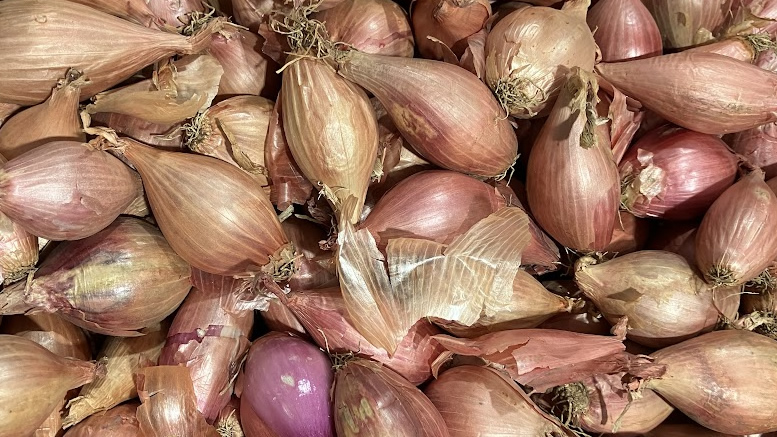The shallot, a robust and versatile member of the onion family, boasts a rich history dating back to ancient times, particularly in Asian cuisine.
With origins in Asia, shallot’s small, elongated bulbs and slender, hollow leaves contribute a distinct flavor profile to a wide array of dishes. Renowned for their mild yet aromatic taste, shallots are cherished for their ability to elevate the flavor of meats, sauces, and soups across various Asian culinary traditions.
The naming of shallots, green onions, scallions, and spring onions across different countries and culinary traditions can be very confusing. Although they all come from the allium family, they are different in their looks and their flavors. A shallot is a small-sized elongated bulb that has a mild flavor, used in cooking primarily to add a subtle oniony taste. Green onions and scallions are two names for the same plant: young onions, long green stalks, and small white bulbs. Typically, these are used in raw salads or as an ingredient of the garnish. In fact, in some countries such as the UK and Australia, they even call green onions spring onions, and spring onions are called shallots in some Australian states. This naming discrepancy can lead to confusion in recipes and culinary discussions, highlighting the importance of understanding regional terminology when exploring different cuisines. As a bonus, their flavor profiles are not so different that it would ruin your dish if you decided to swap one of these varieties of onions for another.
In Asian cooking, shallots are an essential ingredient due to their subtlety and complexity in taste. From aromatic stir-fries and robust broths to more delicate seafood dishes, shallots add richness to the flavors and aromas of classical Asian foods. Their versatility extends from applications that are raw to those that are cooked, and they can be used for making deep and fascinating preparations while still holding their characteristic character.
Furthermore, shallots find themselves highly regarded in many households across Asia, not only for their culinary input but also for their nutritious value. Shallots have high levels of most necessary nutrients and antioxidants, leading them to be very effective in promoting health from different perspectives, making them the top choice among professional cooks or consumers who wish to maintain a healthy life. Whether sautéed golden brown or julienned to bring out the mild crunch, shallots will always find their place in Asian dishes, enhancing them with that distinct flavor and aroma.
Use and Storage
Like other onions, shallots are generally available at most large supermarkets and it is recommended to select bulbs that are firm, dry, and free from sprouts or soft spots. When using shallots, their mild yet distinct flavour makes them ideal for both raw and cooked dishes, such as vinaigrettes, sauces, and sautés. To prepare, simply peel away the papery skin and finely chop or slice the shallot as required by the recipe. Proper storage is essential to maintain their quality; keep shallots in a cool, dry, and dark place with good ventilation, such as a pantry or a mesh bag. Avoid storing them in the refrigerator, as this can lead to spoilage. When stored correctly, shallots can last for several weeks to a few months, ensuring you have this versatile ingredient on hand whenever needed.

